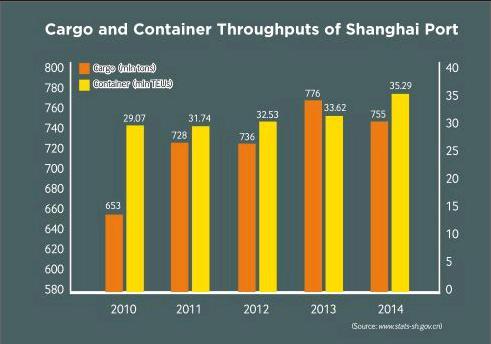Shaping Up to Ship Out
2015-05-26ByDengYaqing
By+Deng+Yaqing

Swathes of multicolored containers decorate the shore as ships sail from the Shanghai Port, one of the busiest ports in the world, which has seen the worlds largest container output since 2010.
Located at the rendezvous point of the Yangtze River and the East China Sea, the port serves the whole Yangtze River Delta, the countrys economic powerhouse, which includes Shanghai, south Jiangsu Province and north Zhejiang Province.
“The Shanghai Port boasts a huge hinterland economy and an advantageous geographical position,” Ding Songbing, General Manager of the Strategy Research Department of Shanghai International Port (Group) Co. Ltd., told Beijing Review, adding that the vital role of the hinterland economy has been proved by the birth and development of other major international shipping centers like London, Rotterdam and Tokyo.
The establishment of the China(Shanghai) Pilot Free Trade Zone (FTZ)—a “testing ground” for further reform and opening up—in September 2013 and a recent approved expansion of the Shanghai FTZ will give the port a further boost to be- come an international shipping hub.
“The establishment of the FTZ provides a propitious environment for the Shanghai Port to make attempts and explorations to compete with its counterparts on the international stage,” said Shi Zhengwei, Director of Shipping Development Department of Shanghai Municipal Transportation Commission (SMTC).
“Since the shipping business is a quite open industry, its development needs an internationally compatible environment,” said Shi.
At a meeting of the Political Bureau of the Communist Party of China Central Committee held on March 24, the 28.78-square-km Shanghai FTZ was approved to expand to 120.72 square km, by adding more industrial parks including the Lujiazui Finance and Trade Zone.
As early as in the 1990s, the Central Government has put forward the idea of building Shanghai into a global shipping hub in Northeast Asia, in order to promote it into a trade and financial center as well as a growth engine driving the economic development of the entire Yangtze River Delta. The State Council has stressed the Shanghai strategy since 2009, and following the establishment of the China (Shanghai) Pilot Free Trade Zone (FTZ) in 2013, the blueprint seems more likely to be brought into reality.
More efficiency
To advance the development of the Shanghai FTZ, authorities have unveiled a basic policy on trade facilitation, which is widely known as“first line decontrolled, second line controlled safely and efficiently.” The so-called “first line” refers to the border, and“second line” refers to the domestic market boundary.
“Now, foreign cargo is al- lowed to be claimed at the customs after entering the zone, which has alleviated pressures on the logistics system,” Shang Junsong, Deputy Director of the Customs Clearance Coordination Department of Shanghai Municipal Office for Port Services, told Beijing Review. “Enterprises can also get imported cargo inspected before they are claimed, which has significantly facilitated customs clearance.”
Thats to say, most of the formalities that enterprises had to go through at the “first line”now have been brought forward or pushed back, Shang explained.
“The new mode has spurred port-related institutions such as Shanghai Customs and Shanghai Entry-Exit Inspection and Quarantine Bureau to establish an integrated supervision system encompassing cargo, company and information,” said Shang.
In 2014, the first “single window” system, which enables cross-border traders to submit regulatory documents regarding matters—like customs declarations, import or export permit applications—at a single location, was promoted in the Shanghai FTZ to further streamline the procedures of international trade.
“In the past, companies had to submit a dozen forms to different institutions. Now, the‘single window system makes it possible for them to fill all the needed information in a large form, which can effectively avoid repeated information identification and unnecessary supervision loopholes,” said Shang.
In July 2013, the Shanghai Municipal Office for Port Services released a three-year action plan for paperless customs clearance in efforts to reduce the use of paper documents in the main points of customs clearance, port supervision and information exchange. In response, the goal of going “paperless” was realized at a container wharf discharge in 2013 and at the customs clearance of air freight exports in 2014.
“The move targets at transferring more paper-based formalities online. Given the huge business volume at Shanghai Port, the cost of documents will be significantly re-duced,” said Shang.
An integration of regional customs clearance systems is also underway. In September 2014, the first five customs from the Yangtze River Delta started reform to streamline customs clearance procedures.
“In fact, roughly 60-70 percent of the overseas cargo exports come from the Yangtze River Delta. The integration will further propel the development of Shanghai Port,” said Shang.
The customs integration reform was expanded to seven more cities on the upper reaches the Yangtze River last December.
“In the past, enterprises in the region have to shuttle among several ports. Now, they can get cleared by customs nearer to them, which is just equivalent to getting cleared at Shanghai Customs,” said Shang.
In 2014, efforts were also made in integrating the inspection and quarantine in the Yangtze River Delta by signing a memorandum of understanding on integrating the inspection and quarantine in the region.
At the executive meeting of the State Council held on March 18, a consensus was reached on innovating the coordination mechanism of integrating customs clearance and pushing forward the national integration of customs clearance.
Better services
Boosted by a strong hinterland economy and a more efficient border service, Shanghai Port is in position to maintain first place in container transportation. However, it has not yet had a great say in the international market, according to Shi.
“Shanghai Port should avoid becoming a‘dock man,” said Shi, explaining that the port should not just be a huge dock for handling cargo.
Efforts should be made to develop the modern shipping services, including shipping finance, insurance, consultation, maritime law, ship survey, said Shi.
Shipping services have made steady progress in recent years. By 2014, there had been 72 international shipping enterprises, 151 international shipping agencies and 102 ship management enterprises in Shanghai, according to the SMTC.
Almost all the major Chinese insurance companies have set up branches in Shanghai and there were nine shipping insurance operating centers in the city by 2014, according to Shi. Bank of Communications Aviation and Shipping Financial Leasing Co. Ltd. was also approved to open in 2014, making it the first branch company under a financial leasing company which got the go-ahead.
“By expanding the opening up of shippingrelated service industries, the Shanghai FTZ is expected to push the course toward building Shanghai into an international shipping hub,”Shi said.
